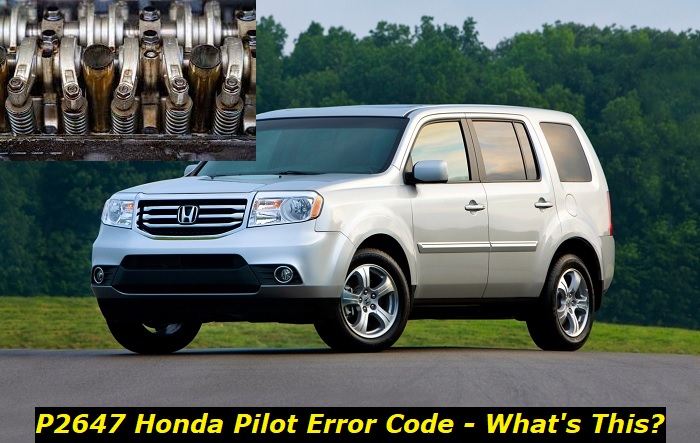Having a P2647 trouble code is not only prevalent for Honda Pilot but also for other Honda and Acura units. The code translates to "A rocker arm actuator system stuck on."
P2647 code highlights
- Level of urgency:High
- Possible culprits:VTEC system problems
- Price for repair:$200 - $650
- Ifneglected:Engine won't work with its full potential
- DIY repairs:Impossible
- Can you drive?Carefully

What Does P2647 Mean for Honda Pilot?
P2647 means A rocker arm actuator system stuck on. This trouble code only implies that a rocker arm actuator is malfunctioning and not doing its work as it should.
A rocker arm actuator controls the rocker arms in a Variable Valve Timing (VVT) system responsible for opening and closing the valves. With a working rocker arm actuator, the system can serve the correct amount of oil pressure needed to achieve optimum performance and efficiency.
But when it malfunctions, it sends the wrong signals to the VVT and lift mechanism,
preventing the valves from opening or closing at the right time.
What is "A Rocker Arm Actuator System Stuck on" Problem?
A rocker arm actuator system stuck on means the system cannot adjust the rocker arms that lift the engine valves to open or close.
To dig into the problem deeper, you must understand the technology within Honda Pilot's Variable Valve Timing And Lift Electronic Control (VTEC). You will find this technology on most Honda and Acura vehicles.
This system utilizes a rocker arm assembly to transmit the camshaft lobe's motion to open or close the engine valves. One end of the rocker arms connects to the camshaft, and the other connects to the engine valves.
The rocker arms should move in response to changes in oil pressure. When the system detects a pressure increase beyond its predetermined speed or load, a pin assembly locks the rocker arms to keep it within the unit's predetermined camshaft profile. This locking pin locks or unlocks the rocker assembly to move freely and follow the camshaft's lobe position.
When the PCM thinks the vehicle engine needs to modify the valve timing, it sends a signal to the oil control actuator. The oil control actuator regulates the oil pressure getting into the system. This actuator changes the pin position, which locks or unlocks the rocker arms.
The rocker arms should keep moving, so they can adjust the timing of the engine valves. But if the rocker arms are stuck, they cannot perform this job. And it will affect the performance of the vehicle. It needs to respond to oil pressure changes to meet the optimum performance of the engine.
What and why it happens? Let's find out.
What are the Causes of P2647 in the Honda Pilot?
1) Defective VTEC oil control actuator
A failing oil control switch is one of the most common issues why the Honda Pilot triggers the P2647 code. It affects the entire performance of the Variable Valve Timing System. It can reduce or increase oil pressure when not needed, respond to wrong signals, or not respond at all.
This control fails due to wear & tear, oil contamination, electrical problems, and a stuck solenoid valve.
In these cases, repair depends on the extent of the damage. You may have to clean a stuck solenoid valve, top up or flush oil, and repair or replace electrical connections.
2) Faulty VTEC solenoid
The VTEC solenoid is a significant component that activates and deactivates after receiving the signal of the PCM. When activated, it regulates the valves when it needs to open or close to let engine oil into the system. But if it is faulty, it could take wrong signals and affect the amount of oil pressure getting into the system or may not respond at all. It may decrease or increase oil pressure unnecessarily.
Also, a faulty VTEC solenoid can result in many problems, such as reduced fuel economy, increased emissions, and reduced power and acceleration. In any case, a faulty VTEC solenoid may cause the rocker arms not to adjust when needed.
If your VTEC solenoid is failing, your best fix is to replace it with a new one.
3) Blocked oil passages
Oil passages should ensure a smooth flow in the entire system. However, blockages restrict the flow and prevent the entry of fresh oil. If contaminants from the oil build up in the passages, it reduces the pressure and could trigger P2647. A failing oil control valve could also decrease oil pressure and cause the rocker arms not to lock or unlock and trigger the P2647 trouble code.
Fixing your oil passages can be daunting when your diagnostics reveal this problem. You must remove the valve cover to see the extent of sludge build-up. You also need to remove connections and bolts to clean the passages if still possible. When cleaning, you also have to drain used oil. And finally, you need to make replacements for the affected components. As I said, the process can be daunting. And it is advisable to leave this matter to the experts.
4) Clogged oil filter
Oil pressure is significant in an efficient VTEC system. With this condition, the oil filter could also trigger P2647 and lead to the rocker arms not locking or unlocking. You should replace the oil filter every time you go for a change oil service or every 7,000 miles. If your Pilot operates over severe conditions, change it every 3,500 miles.
5) Low engine oil levels
For the VTEC to run smoothly, it needs a good amount of oil for lubrication. You can save a lot of VTEC repairs by keeping adequate engine oil levels. Low engine oil levels decrease oil pressure. The oil lubricates many components in the camshaft, including rocker arm.
6) Damaged wires and connectors
Damaged wires and loose connections can affect many electrical components in vehicles. For the VTEC, the oil control solenoid valve connects to the PCM and composes of wires and harnesses to make communication smooth. Any interruption may cause the system not to engage and prevent the rocker arms from moving.
And several events could affect this connection, such as corrosion, wear and tear, and damage. Test the electrical components affected with a multimeter and repair or replace them. Once replaced, check if the trouble code has cleared.
7) Failing PCM
A failing PCM will not send correct signals to the VTEC solenoid, which may open or close the valve untimely. This event would trigger the P2647 and will affect rocker arm adjustments. Sometimes, the problem is in the software or electrical circuits. In any case, you need a qualified technician to perform proper diagnostics, reprogramming, updates, or repairs in the PCM.
What are the Symptoms of P2647?
If you suspect a P2647 trouble code, here are more signs that your A rocker arm actuator system may be stuck:
- Check engine light
- Reduced performance and efficiency
- Reduce fuel efficiency
- Clogs in the VTEC
- Leaks in the VTEC
- Rough running
How to Diagnose P2647 in Honda Pilot?
It's best to consult a qualified technician to diagnose your Honda Pilot. Whether you got this code from your scanner or service shop, you should let experts handle VTEC problems. After scanning, here's how your mechanic should inspect your Pilot:
- Check engine oil levels.
- Check for low oil pressure light.
- Test engine timing.
- Visually inspect VTEC components.
- Test electrical components and circuitry.
- Test and inspect the powertrain module.
Don't worry because most mechanics will explain what is going on with your VTEC engine. Your mechanic will discuss the necessary repairs and replacements needed to fix your VTEC.
Is P2647 serious?
Issues with your variable timing are serious. The VTEC engine is designed for optimum performance and efficiency. It can cause damage to VTEC parts when left unaddressed.
It can cause your vehicle to go into limp mode in the middle of a highway, which may result in accidents.
It reduces the performance and efficiency of your vehicle. It causes increased fuel consumption and rough idling.
Common Fixes for P2647
- Top up or flush and replace our engine oil
- Replace the timing chain or belt
- Use quality and recommended oil for Honda Pilot
- Replace your oil control actuator
- Replace VTEC solenoid
- Replace VTEC components affected
Final Tips
Variable Valve Timing is a crucial system for engine efficiency and performance. You can keep this system in good condition with proper maintenance and keeping your engine oil clean and at an adequate level.
Your manual is helpful material to see when you should change the oil. Find the type and grade of engine oil recommended by your manufacturer. Make it a habit to inspect the oil control actuator and solenoid valve.
Don't forget to check wiring harnesses for loose connections. If you notice your Pilot has been rough idling and the power reduces, bring it to your trusted mechanic.
About the authors
The CarAraC research team is composed of seasoned auto mechanics and automotive industry professionals, including individuals with advanced degrees and certifications in their field. Our team members boast prestigious credentials, reflecting their extensive knowledge and skills. These qualifications include: IMI: Institute of the Motor Industry, ASE-Certified Master Automobile Technicians; Coventry University, Graduate of MA in Automotive Journalism; Politecnico di Torino, Italy, MS Automotive Engineering; Ss. Cyril and Methodius University in Skopje, Mechanical University in Skopje; TOC Automotive College; DHA Suffa University, Department of Mechanical Engineering






Add comment